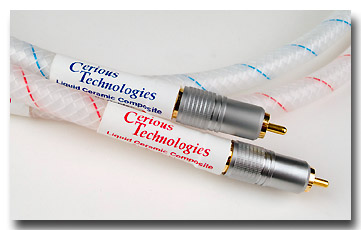
You are reading the older HTML site
Positive Feedback
ISSUE
27
cerious technologies
Liquid Ceramic Composite interconnect and loudspeaker cables - Breaking the Mold
as reviewed by Myles B. Astor

|
|
Few things in audio are as frustrating as reviewing high-end interconnect, speaker and digital cables, and AC power cords. Why? Let's look at the big picture. There is just not a whole lot new happening in the cable world. Most high-end audio cables and cords use an electrical conductor fashioned from some sort of metal such as copper, silver or gold—or some amalgamation thereof, encased in a Teflon or similar type dielectric. There is a limited amount of winding schemes. With burn-in times now surpassing the 300-hour barrier, reviewers spend more time nowadays breaking-in rather than listening to cables. Do not misinterpret the opening soliloquy to mean that interconnect, speaker, and digital cables and AC power cords are not important. They absolutely are! Cables can and often do make or break the sound of a good high-end audio system! Even the turntable motor's (or speed control) AC cord can profoundly affect the system's sound. The most frustrating part about cables however, is that every product has a readily identifiable sonic footprint. For better or worse, cables often obscure and color portions of the character of the electronics and speakers they connect. (That is one good reason for reviewers to employ a stable of in-house cables when reviewing audio components!) That said, several companies have, over the years, bucked convention and designed high-end audio cables based around new non-metallic based conductor technology. The newest kid on the block to eschew "conventional" cable technology wisdom is Robert Grost's Cerious Technology cable company. (Actually Grost is far from a babe in audioland having designed the Unity speakers of yesteryear.) Cerious Technology's liquid ceramic composite based cables are a very tantalizing taste of even better things to come—yet also some ways, seem be a work-in-progress. Getting the Hands Dirty Potential purchasers should know a few items before getting to the review. First, the Cerious liquid ceramic composite cables are far from the most flexible cables on the market. No, they are not as stiff as XLO, but do not expect to bend the Cerious cables around any sharp corners or place them in tight quarters. Next unlike many other cable designers, Cerious cables designer Robert Grost feels it's more important to hook his cables up and leave them alone rather than worrying about the number of hours of burn-in. Grost reckons the cable should be left undisturbed for at least a week and preferably 300 hours to allow for the damping properties of fluid to fully lower the cable's noise floor. Finally, the speaker cable used in this review was outfitted with non-standard banana plugs instead of the more usual spade lug connection (this was because Dave Clark was originally going to do this review and requested the banana plug). Let us call this one a trade-off as some designers feel banana connections have more contact area; on the downside, bananas can't be tightened down like spade lugs. Firing it Up In order to merit serious consideration, a cable must first and foremost exhibit a linear frequency response—and in particular freedom from upper midrange artifacts (simply put, a combination of frequency response aberrations and distortion. For more, see Jung and Curl's early work with capacitors). The Cerious Technology interconnect and speaker cable combination pass this test with flying colors lacking any trace of the upper midrange hardness or artificial sense of detail so commonly encountered in many of its lesser priced brethren. While the cable's lack of brightness is certainly a plus, some listeners may find with extended listening that the Cerious Technology cables slightly soften and darken the upper octaves; this imparts a slight gray coloring. In other words this, as do many other of this cables faults, lie more to the side of omission than commission. The Cerious' cable's slightly subtractive nature prevents the full appreciation of exceptionally well recorded live albums. Take for instance, Classic Records' reissue of the ‘68 Bill Evan Live at Montreux Jazz Festival (Classic Reissue Verve V6-8762), specifically the "Nardis" track. Listeners intimately familiar with this recording will immediately note a decreased sense of hall ambience and space. In the end, this decreased ambiance retrieval results in recordings sounding slightly more alike than they should. On the positive side, Evans' piano has a real sense of size and palpability. Each of the instruments is easily located and visualized on the stage; on the other hand, Evans' piano isn't fully fleshed out and there is a greater sense of his piano sitting in the listener's room rather than the original recording venue/casino. The audience is seated closer to the listener and their applause has a slightly disembodied sound. When it comes to recreating the piano's harmonic structure, the Cerious cables slightly round the leading edge of the transient attack and the truncated the decay of notes. In the end, this in combination with some missing microdynamics results in the music sounding just a touch slow, not unlike my notes say, the old, somewhat overly romantic sound of yesteryears Koestsu cartridges. Jack deJohnette's drums on the Bill Evans album are slightly bettered reproduced than his cymbals. DeJohnette's drums are clean and fast but there's less sense of his drum rattling and feeling of the space within his drums. Cymbals exhibit a loss of finesse, delicacy, and ultimate extension. There's a feeling that opening up the upper octaves would greatly improve the cable's transparency.
Another virtue of the Cerious liquid ceramic
composite liquid cable is a sense of quietness, continuousness, and
smoothness. There's no sense of mechanicality, edge or harshness. On a
non-technical level, it's as if some distortions present in many
metal-based cables cause the ear to momentarily shut down for self
preservation. This smoothness is especially evident on vocals recordings
such as the Tony Faulkner engineered Songs from the Fayrfax
Manuscripts (MHS 4649) featuring the Pro Cantione Antiqua and
Renaissance Viol Consort. On this recording, Faulkner magically captured
the essence and correct scale of an early music group. Played back using
the Cerious Technology liquid ceramic composite interconnect and Finally, there's probably no tougher road test for any high-end audio product than John Cage's "Third Construction" from the album entitled Pulse (New World Records NW319). This Anthony Salvatore (one of the engineers from the golden years of RCA's Layton/Mohr classical record era) recording done at RCA's Studio (and having heard several recordings done there, does a nice job of capturing the stage) Written for four percussionists playing an immense and varied number of percussion instruments, this piece is noteworthy for Cage's use of three timbral groups (including metal, wood and skin in addition to sustained such as the bass-drum roar and blown conch shell). As with the previous recordings, the cables present an extremely smooth sound, free of any sense of grain. Upper frequencies are a touch reticent resulting in a loss of extension on the tin cans. Low level resolution, in particular instrumental duets at the soft end of the dynamic spectrum crucial to revealing Cage's intent, are not on the same level as say my reference AudioQuest Sky interconnect and Everest speaker cables. With this piece, the reproduction of dynamic accents during more densely orchestrated percussive sections (or say on string instrument duets on other albums) are on occasion slightly congested. The Cooldown Cerious Technology liquid ceramic composite interconnect and speaker cable are an interesting alternative in the mid-priced cable arena. The Cerious Technology cables avoid many pitfalls of similarly priced metal-based cables and most of its faults lie on the side of omission rather than commission. On the other hand, some listeners will find with extended listening, the cable's low level resolution and ambience retrieval and microdynamic compromises more wearing than others. In the end, some of these omissions seem to make recordings sound somewhat more alike than they should. With an opening up of the frequency extremes and improved low-level resolution, this cable could be very exciting addition to the high-end cable market. This cable may even be a good match and find a happy home in those systems that lean to the bright end of the sonic spectrum. Technical Highlights In the case of the Cerious interconnects, the all important conductor leg's conductive lattice is produced by placing a composite micro-fiber saturated in a liquid synthetic ceramic under high pressure conditions. (See Cerious' soon to be updated website for a much more in-depth discussion of their ceramic cable technology) According to the website, this process produces a non-magnetic conductor that avoids the common pitfalls of metal based cables such as skin effects and the absorption of RFI and EMF. This also results in a reduction in the cable's mass the leads to reduced mechanical energy storage. According to the literature, this conductor is then covered in an anti-static liquid to lower the noise floor and then inserted into a pure Teflon tube in order to load the synthetic ceramic liquid even further. In the end, this construction technique results in even greater internal and external mechanical stability. Grost adds to that, " one of the tricks to designing the cables is experimenting and choosing the correct proportions of the conductive fiber and fluid to maximize the properties of both and obtain the best sound. As well, all know and Grost confirms, "even the best test equipment and MELISSA aren't a substitute for listening to the cables." In other words, measurements don't in this instance correlate with the listening experience. Finally, the locking connectors are added to the cable using a compression fit and hermetically sealed. Grost took a slightly different approach to designing the Cerious speaker cables. Here because of problems in loudspeaker/amplifier interfaces (namely the loading of passive crossovers), Grost chose to construct the negative/ground cable from a mix of conductive composites and wire. The positive lead according to the literature, on the other hand, employs hundreds of stands of microfiber saturated in proprietary liquid ceramic. The two conductor bundles then undergo the same construction technique used for the interconnects synthetic liquid ceramic jacket (albeit a larger jacket to allow for greater volumes of ceramic damping material). Myles B. Astor
Cerious Technology Liquid Ceramic
Composite Conductor Audio cables
Cerious Technologies
|